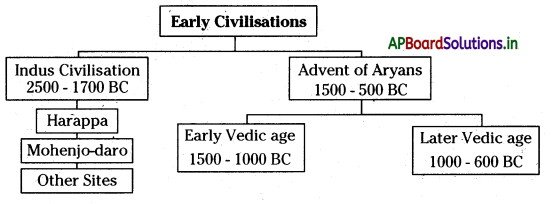Students can go through AP State Board 6th Class Social Studies Notes Chapter 6 Early Civilisations to understand and remember the concept easily.
AP State Board Syllabus 6th Class Social Studies Notes Chapter 6 Early Civilisations
→ India has a long history, it has a rich culture and tradition. India is a living museum of the ancient world and its lost civilizations. Most historians thought that Indian history began with the Vedic period until the last century. The excavations of Mohenjodaro and Harappa in the 1920s pushed back our history by at least 2000 years. They found an excellent and advanced civilization earlier in the Vedic period. It is called the Indus valley civilization or Harappan civilization.
→ Indus valley civilization developed along the Rivers Indus and Ghaggar-Hakra. The traces of these rivers are found by satellite images and other sources also.
→ The cities of the Harappan civilization were well planned. They had wide roads, public wells. In Mohenjodoro, ‘the Great Bath’ (a great tank for public bath) was found. Lothal was a popular harbor in those days.
→ They had a well-planned underground drainage system which shows the importance given to the cleanliness and public health.
→ The Harappan people built their houses with dried or baked bricks. There were two-storeyed buildings also. Every house had a well for water and bathrooms with pipes that carried waste into the main drains.
→ Harappans are credited for growing cotton for the first time. Production of baked bricks was another occupation. They rear cattle, goats, pigs, dogs, camels, and donkeys. They carried out trade activities through the port Lethal -in the Arabian sea with Mesopotamia, Egypt, Iran, etc.
→ Women used ornaments like necklaces, armlets, finger rings, bangles, earrings, nose studs, etc, They knew cosmetics and used perfumes.
→ They grew Wheat, barley, peas, lentils, mustard, etc., Dance, chess, music, marbles, and dice were their entertainments. Bullfighting was their major entertainment. Small idols of Ammatalli (Mother Goddess) and the statue of a dancing girl and the stone idol of the bearded man are excellent artifacts.
→ They worshipped Pashupathi (Siva) and Mother Goddess. The symbols of Swastika are most commonly found. Harappans had developed their own unique script and language. Harappans were the first to develop a system of standardized weights and measures. The measurements and weights of Indus people also moved to Persia and Central Asia.
→ Archaeologists thought that change in the course of the Indus River and forbids led this civilization to decline. And some others believed that the drying up of the Indus River and its tributaries made the people leave this area. After Indus valley civilization Aryans came into existence.
→ The river Ghaggar – Hakra which disappeared in the Thar desert of Rajasthan is believed to be the ancient river Saraswati. The Rigveda mentioned the river Saraswati many times.
→ The Vedic literature is the major source to know about the Aryans. The term Veda means “superior knowledge” in Sanskrit. It is the knowledge of knowing oneself or self-realization. Four major Vedas constitute Vedic literature. They are – Rig Veda, Yajur Veda, Sama Veda, and Atharvana Veda.
![]()
→ The period of Vedic Civilisation (1500-500 BCE) is divided into two broad parts:
- Early Vedic Period (1500-1000 BC), also known as Rig Vedic Period.
- Later Vedic
→ As time passed by the Vedic people migrated to the plains of Ganga and Yamuna from ‘ the plains of rivers Indus-Saraswati. They crossed the mountain ranges of the Vindhyas and moved towards the south.
→ The Ramayana and The Mahabharatha are two great epics. The Ramayana (Adi kavya) was written by Maharshi Valmiki in Sanskrit. The Mahabharata was written in Sanskrit by sage Vedavyasa.
→ Civilizations: The stage of human social and cultural development and organization that is considered most advanced.
→ Sub-Continent: A large area of land that is part of a continent.
→ Trade: The action of buying and selling göods and services.
→ Vedas: Holiest books of Hindû religion.
→ Brahmanas: The lengthy commentaries of Vedas.
→ Upanishads: A series of Hindu sacred treatises.
![]()
→ Barter System: To exchange goods for other goods or services without using money.
